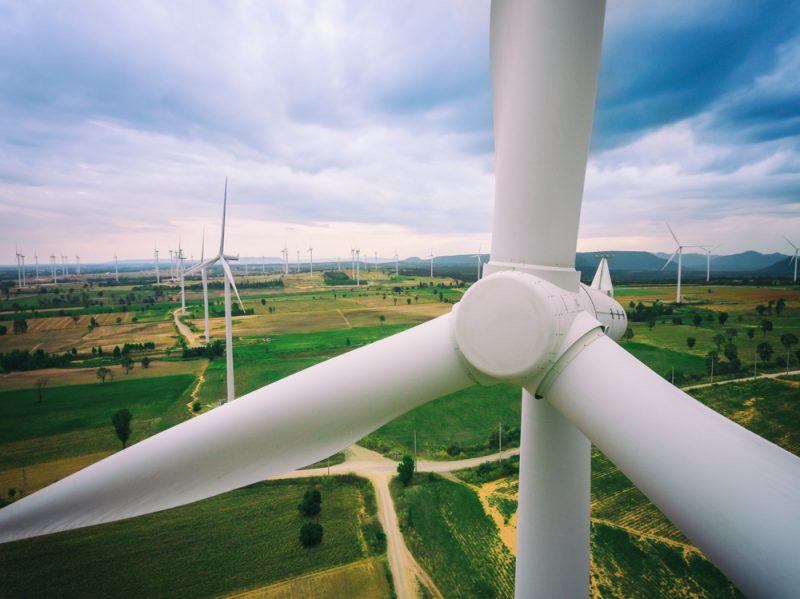PacifiCorp’s new energy plan proposes aggressive wind-powered changes

Portland, Oregon-based PacifiCorp on Tuesday filed a $3.5 billion expansion plan with utility regulators across its six-state territory proposing to go from being a predominately coal-generating electricity supplier to a major wind-powered energy provider.
The plan is considered by company officials to be a road map to help PacifiCorp provide reliable electric service to customers at the lowest cost.
The utility, owned by Warren Buffett’s Berkshire Hathaway, filed an Integrated Resource Plan (IRP) that’s set to be in place by 2020.
The quick turnaround time was spurred by the federal government’s Production Tax Credit (PTC), a 2.3 cents-per-kilowatt-hour incentive for wind power. That amount, however, was set to decrease at the end of 2016 for projects not yet under construction. PacifiCorp had purchased turbines before the new PTC deadline took effect, qualifying some of its projects for the full PTC.
By moving to complete the wind upgrades and new wind developments by 2020, PacifiCorp now can use the PTC and provide a net savings for customers over the life of the projects.
Currently, PacifiCorp generates almost 60 percent of its electricity for 1.8 million customers from coal. And the utility now owns or purchases 2,333 megawatts (MW) of wind resources.
All of that would change under the IRP.
PacifiCorp spokesman Bob Gravely told Daily Energy Insider on Wednesday that the company will be installing longer blades on the turbines and updating other components with better technology. Gravely said the improvements will increase the energy produced by the turbines by 20 percent on average, depending on the turbine.
“The increase comes in part by allowing the turbines to produce more energy in a wider range of wind conditions,” he said.
The upgraded technology also will extend the operating life of the wind projects for another 10 years. And it will provide greater control over consistency of power production and voltage, Gravely said, which will make wind from the wind farms easier to integrate onto the grid and improve reliability.
“One of the challenges of wind is it’s weather-dependent and variable nature,” he added.
Most importantly, he added, the upgrades will requalify the entire wind projects for the federal PTC for another 10 years. “This will not only pay for the cost of the upgrades but return a net savings to customers,” Gravely told Daily Energy Insider.
Big picture plan
Overall, PacifiCorp’s long-term energy plan—or preferred portfolio—is to put new investments in renewable energy resources, upgrade the existing wind fleet, and install energy efficiency measures to meet future customer energy needs.
For example, PacifiCorp’s 59 percent coal generation this year would eventually decrease to 31 percent coal in 2021, according to the IRP.
Natural gas now currently provides 14 percent of PacifiCorp’s power, but is projected to provide 30 percent of the company’s power by 2036, the IRP says.
By 2020, with all-in economic savings for customers, PacifiCorp will add 905 MW of repowered wind resources, 1,100 MW of new wind resources, and a new 140-mile, 500-kilovolt transmission line in Wyoming to access the new wind resources and relieve congestion for existing capacity, according to the IRP, which “reflects a cost-conscious transition to a cleaner energy future.”
The 2017 IRP also looks 20 years down the road and includes: 1,959 MW of new wind resources, 1,040 MW of new solar resources, 2,077 MW of incremental energy efficiency resources, and 365 MW of new direct load control capacity.
The preferred portfolio also assumes existing owned coal capacity will be reduced by 3,650 MW through the end of 2036, including assumed coal retirements at the end of that year, the IRP says. The first new natural gas resource would be added in 2029.
Moving fast
Regarding PacifiCorp’s new wind plans, “We will be starting regulatory approval steps right away and plan to issue a request for proposals to build the wind turbines by August of this year,” Gravely said.
On the wind repowering, Gravely said the company has been working with the manufacturers of the turbines on planning for the upgrades and has already purchased some of the equipment.
“Because the upgrades are to existing facilities, there isn’t a need for new siting or other permitting, however we still will need to demonstrate cost effectiveness and win approval from state regulators,” he said.
On the new transmission line, Gravely said that the route has been approved by the Bureau of Land Management, but there will be a number of additional steps that PacifiCorp will need to take to secure the land, as well as obtain environmental and other approvals.
PacifiCorp provides electric service in six western states and operates as Pacific Power in Oregon, Washington and California, and as Rocky Mountain Power in Utah, Wyoming and Idaho.
